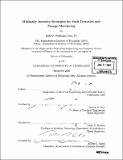Minimally intrusive strategies for fault detection and energy monitoring
Author(s)
Cox, Robert Williams, 1979-
DownloadFull printable version (25.97Mb)
Other Contributors
Massachusetts Institute of Technology. Dept. of Electrical Engineering and Computer Science.
Advisor
Steven B. Leeb and Leslie K. Norford.
Terms of use
Metadata
Show full item recordAbstract
This thesis addresses the need for automated monitoring systems that rely on minimally intrusive sensor arrays. The monitoring techniques employed in this thesis require fewer sensors because they take a different approach to the measurement problem. Specifically, these techniques use the power distribution network in the target system as a power source, a sensor array, and a communications channel. In this "multi-use" approach, the only measurement sources are a set of centrally located electrical transducers (i.e. voltage and current sensors) and a set of remotely located sensors that communicate with a central processing unit via power line modems. In general, these systems determine the status of critical loads or systems using only electrical data. Thus, remotely located sensors are only employed in order to gather information that would be difficult, if not impossible, to obtain electrically. Examples of such quantities include air exchange rates and occupancy levels in individual rooms. This thesis describes the development and application of several critical features of the minimally intrusive monitoring systems described above. First, it presents several model-based methods that make it possible to use electrical data to detect faults in certain mechanical systems. (cont.) In particular, two such models are described. The first of these is intended to be applied in systems in which an electromechanical actuator cycles its operation according to the value of some other variable, such as a pressure or a temperature. Examples include compressed air and vacuum systems. The other model is used to diagnose the impending failure of the mechanical coupling through which a motor drives an inertial load such as a pump impeller. This thesis also describes the development of a minimally intrusive airflow monitoring system that uses ozone as a tracer gas. This system fits easily into the "multi-use" framework because it relies on a network of distributed ozone generators and detectors whose operation is coordinated via power line communications. Finally, this thesis also presents and demonstrates a method for detecting the operation of various electrical loads using transient changes in the measured line voltage. This technique makes it possible to use "plug-in" sensors to determine the operating schedule of each of the various loads in a home or commercial facility. All of the techniques and methods described here are demonstrated experimentally.
Description
Thesis (Ph. D.)--Massachusetts Institute of Technology, Dept. of Electrical Engineering and Computer Science, 2006. Includes bibliographical references (p. 185-196).
Date issued
2006Department
Massachusetts Institute of Technology. Department of Electrical Engineering and Computer SciencePublisher
Massachusetts Institute of Technology
Keywords
Electrical Engineering and Computer Science.